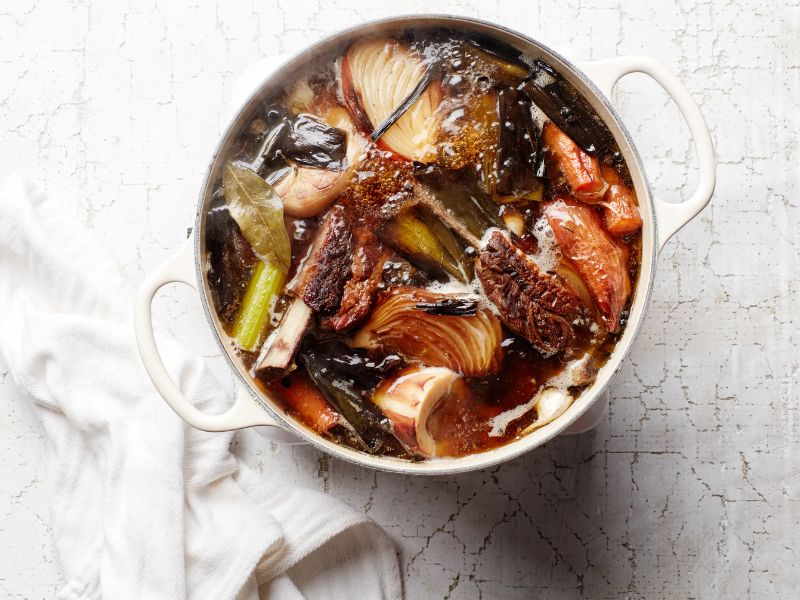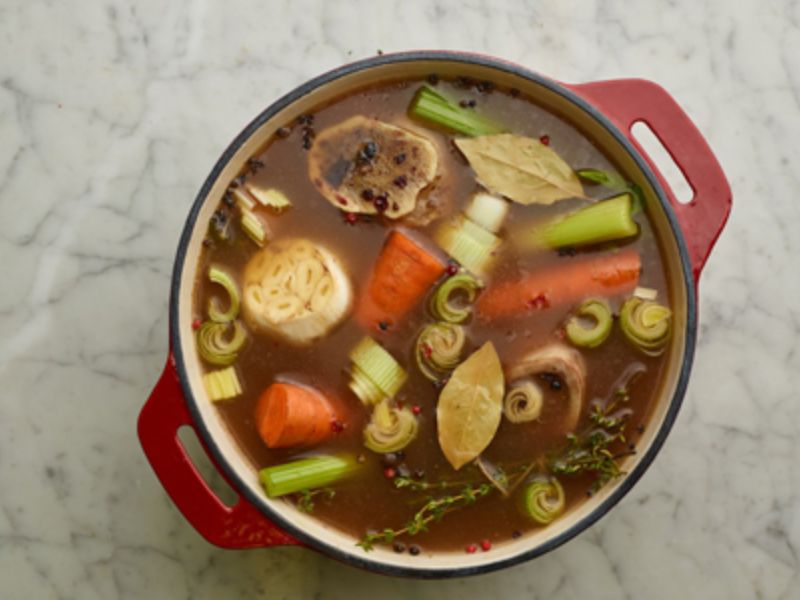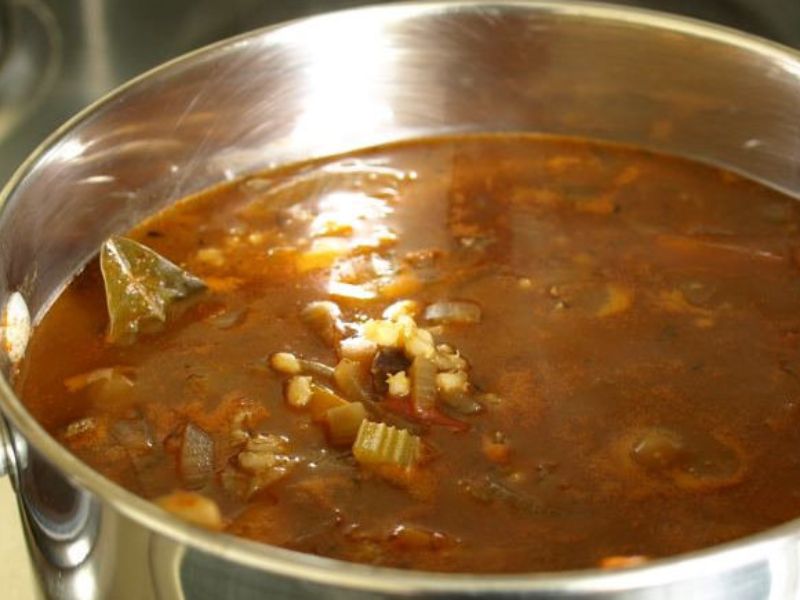How To Thicken Beef Broth?
Simmering a combination of beef bones, vegetables, and aromatic spices creates a rich and flavorful cooking liquid known as beef broth. This culinary elixir is commonly referred to as “stock” in certain culinary circles. Its versatility shines as it can be used in various recipes, serving as a replacement for water in soups and sauces, elevating their taste to new heights.
Not only does beef broth enhance the flavors of soups and sauces, but it also works wonders when cooking rice and pasta. When prepared together, the broth infuses these staple ingredients with a savory essence, transforming them into delectable and comforting dishes.
Moreover, beef broth serves as an excellent base for braising liquids used in cooking beef and other meals. As it simmers alongside the meat, the broth aids in the breakdown of collagen, a tough connective tissue, resulting in tender and succulent beef even from the most challenging cuts.
While the idea of creating your own beef broth may be enticing, it can be challenging to find a reliable and affordable source for this essential ingredient. However, fear not! If you’re up for the task of crafting your own broth, we’ve got you covered with tips on how to thicken beef broth and enhance its flavor that will elevate your culinary creations to new heights.
Why Should One Consider Thickening Beef Broth?
The traditional form of beef broth is often characterized by its thin and watery consistency. This is because when meat and vegetables are cooked in water, the proteins within them break down and release liquid.

Furthermore, as the bones simmer in the liquid, they release minerals that contribute to the distinct flavor of the broth. However, over time, these components can be lost through evaporation, resulting in a reduction of fluid content.
Yet, it is essential to exercise caution when thickening the broth. If you opt for methods such as cooking rice or adding other carbohydrates, you may inadvertently dilute or alter the original flavors of your dish. Therefore, the challenge lies in finding a way to enhance the richness and thickness of the broth while preserving its full-bodied taste.
So, how can you achieve a more substantial consistency in beef broth while ensuring its flavor remains intact?
How to Make Beef Broth Thickener
Addition to traditional methods like using corn starch or flour to thicken beef stock, there are other simpler alternatives available that yield similar results.

One such method involves reducing the volume of the stock by boiling off a portion of the liquid. Alternatively, you can choose to lower the heat and allow your beef broth to simmer for an extended duration.
These approaches provide three viable options for enhancing the richness and thickness of your beef stock.
Thicken beef broth by reducing it
When it comes to achieving a thicker consistency for your broth or soup, one straightforward method is to reduce it. By reducing the liquid, you not only increase the thickness but also intensify the flavors of the broth.
To begin, remove a portion of the liquid from the soup. This extracted portion can then be boiled down until it reaches the desired consistency. Once this concentrated liquid is added back into the mixture, you’ll notice a remarkable improvement in both the taste and thickness of the beef stock.
Under specific conditions, proteins present in liquids have a tendency to aggregate, forming solid particles. These particles can create a dense sludge that settles at the bottom of your pot. Interestingly, this sludge serves as an ideal ingredient for making rich and flavorful gravy.
Thicken beef broth with cornstarch
Corn starch-derived flour is devoid of any discernible taste. This versatile ingredient serves as a fundamental component in numerous culinary preparations, helping to attain the desired texture and thickness in both liquids and solid dishes.

A ubiquitous presence in kitchens, corn starch finds frequent employment as a thickening agent, particularly in the context of enriching broths.
When seeking to achieve a thicker consistency in beef broth, alternative methods can be employed in place of corn starch. By incorporating 2 tablespoons of corn starch per cup of liquid into the saucepan once the broth has reached a boiling point and has been reduced to the desired thickness, the broth can be successfully thickened. During this process, continuous stirring is crucial to ensure the absence of any clumps or lumps.
Following the removal of any lumps, reduce the heat to a low setting and allow the broth to simmer for approximately 5 minutes. This gentle simmering allows for the flavors to meld together harmoniously, resulting in a well-rounded and enticing culinary creation.
Slow cooking beef broth
If you decide to simmer beef broth, it is highly recommended to do so over a low heat setting for an extended period. This gentle cooking process allows the flavors to develop and intensify over time, resulting in a truly delicious and savory soup.
During the prolonged simmering, the meat in the broth undergoes a slow decomposition process. As a result, the meat gradually releases its flavorful essence, infusing the entire soup with a deep and robust taste. The long cooking duration allows the natural flavors to meld together harmoniously, creating a broth that is rich in umami and satisfaction.
As the simmering progresses, you’ll notice a fascinating transformation occurring in the saucepan. The meat, which initially floats in the broth, gradually starts to sink to the bottom. This change is a positive sign, indicating that the flavors have fully permeated the broth. Additionally, the sinking meat contributes to the thickening of the broth, imparting a luscious and velvety texture. The resulting broth becomes a comforting and hearty base, capable of enhancing the flavors of any ingredients you choose to add.
Therefore, by investing time and patience into simmering beef broth over low heat, you will be rewarded with a soup that not only tantalizes your taste buds but also showcases the remarkable depth of flavors achieved through this slow cooking process.
Thicken beef broth with flour
If you have a gluten intolerance, you can make beef broth thicker by incorporating flour into the recipe.
To achieve this, a general guideline is to use 1 tablespoon of flour for each cup of liquid present in your pan. Begin by combining the flour with 2 tablespoons of cold water in a pot, stirring continuously until it forms a smooth slurry.
Next, gently heat the mixture over low heat, allowing it to thicken gradually. Once the desired consistency is reached, you can incorporate this thickened mixture back into the beef broth.
This method ensures a gluten-free option for thickening the beef broth while maintaining its delicious flavor.
Thicken beef broth with Roux
The process begins by gradually whisking flour and melted butter together, creating a roux—a fundamental base used in various culinary preparations.

As the mixture is simmered for a certain duration, its consistency transforms, thickening and becoming cohesive, akin to the texture of a delicious gumbo or savory gravy.
To achieve the desired results, it is recommended to add one spoonful of flour for every two tablespoons of oil in the saucepan. As the mixture heats over medium heat, it is important to stir it regularly until it resembles the texture of wet sand, ensuring even distribution of the ingredients.
Next, the roux is carefully poured into the beef broth, followed by thorough mixing to incorporate all the flavors. It is important to note that after adding the roux to the pot, additional heating may be required for several minutes to achieve the desired thickness, allowing the ingredients to meld together harmoniously.
Enhancing the Flavor of Beef Stock
One effective method to elevate the flavor of beef broth is by incorporating a variety of herbs and spices. During the simmering process, consider adding a delightful blend of parsley, savory, basil, thyme, or sage to infuse the soup with aromatic notes that will tantalize your taste buds.
To further enhance the taste, just before serving, season the beef broth with a pinch of salt and a sprinkle of pepper. This simple step will bring out the natural flavors of the broth, providing a balanced and savory experience.
Incorporating vegetables such as carrots and celery is an excellent way to enrich the beef stock. As the soup gently boils, these vegetables will soften, releasing their delightful essence into the liquid. This infusion adds depth and complexity to the broth, creating a more satisfying and wholesome taste.
A helpful tip to maximize your ingredients is to save and reuse the drained vegetables from the pot for future meals. This resourcefulness ensures that no flavor goes to waste and allows you to enjoy the benefits of these aromatic vegetables in other culinary creations.
For an extra touch of sophistication, consider introducing a shot or two of liquor while the beef broth is simmering. In French and various European cuisines, this technique is widely embraced as both a flavor enhancer and a preservative. Opt for white wine, beer, or a similar beverage to impart a subtle yet distinct taste that will further elevate the overall flavor profile of the broth.
By exploring these flavorful options and experimenting with different combinations, you can unlock a world of culinary possibilities and create beef stock that is rich, aromatic, and truly unforgettable.
Conclusion
In conclusion, beef broth proves to be an exceptional option when it comes to creating the perfect base for soups or sauces. Not only does it enhance the flavors of your culinary creations, but it also provides a solid foundation that can elevate your dishes to new heights of deliciousness.
Moreover, the versatility of beef broth extends beyond traditional soups and sauces. With the help of various cookbooks and abundant online recipes, you can explore a vast array of possibilities to craft wonderful gravies and other delightful dishes using this ingredient. The richness and depth it adds to your culinary creations will undoubtedly leave a lasting impression on your taste buds and those of your lucky guests.
By following the aforementioned advice, you will be equipped with the knowledge and techniques necessary to create a thicken beef broth that is not only flavorful but also concentrated, allowing you to achieve a truly satisfying culinary experience in the comfort of your own home.
Feel free to adapt and modify the procedure as needed to accommodate your preferences and experiment with different flavors, as beef broth serves as an excellent base for a variety of soups and broths. Let your creativity take the lead and explore the endless possibilities that lie within the realm of homemade soups and broths.





